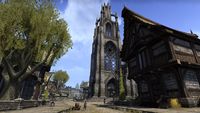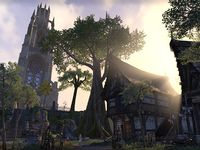Lore:Zantonius
| Governor Zantonius | |||
|---|---|---|---|
| Race | Imperial | Gender | Male |
| Born | First Era Kvatch |
||
| Resided in | Kvatch Southpoint |
||
| Governor of Southpoint | |||
| Reign | 1st Rain's Hand, 1E 2729- |
||
—Zantonius[1]
Zantonius was the founder of Southpoint and its first Imperial Governor during the late First Era.[1] He oversaw the construction of the Cathedral of the Golden Path.[2]
History[edit]
According to The Founding of Southpoint, a document issued by Zantonius's Provincial Office, he was born the eldest son of a Colovian farmer from Kvatch. After the tragic death of his mother, Zantonius took on a commanding role in his family. Despite these humble beginnings, he was always known as a bright and cheerful man. As his younger siblings came of age, Zantonius grew weary of life as a farmer and set out to make a name for himself. He traveled to the Imperial City and enlisted in the Imperial Legion. His rise through the Legion's ranks was rapid—his commanders supposedly praised him as strong as a bear and swift as a fox. Eventually, he was stationed in northern Valenwood, where, according to biased documents issued later by his own office, he would prove that his tactical mind was on par with the greatest generals of the Second Empire.[1] However, the historical records compiled in The Fall and Rise of Reman's Bluff paint a different picture. According to a fragment from one of the Commander's Journals, dated around 1E 2720, Zantonius was described as a foolish and privileged man, the son of a wealthy landowner.[3]
The account favoring Zantonius claims that one dark night in the month of Second Seed, while Zantonius stood vigilant at his post in Reman's Bluff, he single-handedly thwarted a Wood Orc raid on his camp! For his supposed bravery and tactical skill, Zantonius was awarded command of a cohort of soldiers and tasked with building a fort in the name of the Empire. Leading these troops, he marched south into the Kingdom of Grahtwood.[1] However, a research based on his commander's journal paints a different picture. It suggests that Zantonius shot down an Orc shaman who was approaching with an offer of peace. His commander, unimpressed by his actions, noted in his journal that if Zantonius hadn't been the son of an important landowner, he would have been thrown into the Imperial prison. Instead, the commander assigned him to lead a group of underperforming soldiers and sent him south to the Long Coast, where he was tasked with a less urgent assignment.[3]
Regardless, roughly nine years later, the city of Southpoint was founded in 1E 2729 by Zantonius who was appointed its Governor. It quickly became the primary port and Imperial colony within the Kingdom of Grahtwood, which was then an administrative division of the Second Empire in Valenwood. On 1st Rain's Hand, 1E 2729, the document of the Founding of Southpoint was issued, marking the official establishment of the city.[1][2]
In the document, Zantonius declared the land to be named Southpoint, and although his original mission was to build a stronghold of Imperial power, he chose instead to establish a fortified town. Under his leadership, Southpoint received strong defensive walls, a quick-response force to deal with Bosmer insurrectionists, and a port that soon outstripped Haven—a backwater trading post—in traffic. Zantonius also planned the construction of what he hoped would one day become the grandest cathedral in all of Valenwood.[1] This cathedral, the Cathedral of the Golden Path, still stood long after its construction, remaining a prominent landmark as of 2E 582.[2]
During the Second Era's Interregnum, various items from Fort Zantonius circulated as contraband across Tamriel, including a brass candlestick in the Nibenese style and an antique Imperial serving platter engraved with an image of the now-ruined fort in its prime.[4][5]
See Also[edit]
Books[edit]
- The Fall and Rise of Reman's Bluff by Praetor Aemilianus Lector — Details of an Imperial fort besieged by Orcs in the late First Era
- The Founding of Southpoint by the Provincial Office of Governor Zantonius — Imperial propaganda for citizens of Southpoint
References[edit]
- ^ a b c d e f The Founding of Southpoint — the Provincial Office of Governor Zantonius
- ^ a b c Cathedral of the Golden Path's loading screen in ESO
- ^ a b The Fall and Rise of Reman's Bluff — Praetor Aemilianus Lector
- ^ Imperial-Style Brass Candlestick item description in ESO
- ^ Antique "Fort Zantonius" Serving Platter item description in ESO

